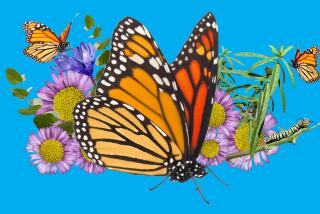INSECTS
- Share via
They live almost everywhere--in the air, water and soil, in and on animals, including humans. Insects make up almost 90% of animal life on Earth. Without them, many plants could not survive. And though small insects such as flies, fleas and ants are the most familiar to us, much larger ones are common. The stick insect of the tropics can grow to a length of 14 inches. Want to learn more about insects? Use the direct links on The Times’ Launch Point Web site. https://www.latimes.com/launchpoint/
LEVEL 1
Entomology for Beginners: Learn the basic body parts of an insect as well as the two types of development, or “metamorphosis,” that insects can experience.
https://www.bos.nl/homes/bijlmakers/ento/begin.html
Children’s Butterfly Site: Color your way through the life cycle of the monarch butterfly and find the answers to frequently asked questions about butterflies and moths.
https://www.mesc.nbs.gov/butterfly.html
University of Kentucky Department of Entomology Youth Facts: This informative site has articles on all types of insects. Learn about “bug food,” see if you can name the “mystery bug,” and read about how different insects survive winter.
https://www.uky.edu/Agriculture/Entomology/ythfacts/entyouth.htm
LEVEL 2
Minibeast World of Insects and Spiders: What do entomologists do? What kinds of plants attract butterflies? This site answers those questions and more with articles, stories, poems, folk tales, quizzes and even some jokes.
https://www.tesser.com/minibeast/
Bug Club: Learn how to take care of a pet cricket, find a pen pal from around the world for exchanging bug stories, or read the club newsletter containing facts on bugs.
https://www.ex.ac.uk/bugclub/
Monarch Watch: Learn about the life cycle of the monarch butterfly, including its annual migration to the warmer climates of California and Mexico. Find out how butterflies are tagged for identification, who is watching for monarchs in your area and how you can raise monarchs at home.
https://www.MonarchWatch.org/
LEVEL 3
Gordon’s Entomological Home Page: A comprehensive site that includes information on insect anatomy and classification as well as a glossary and other resources.
https://www.ex.ac.uk/~gjlramel/
CSULA’s Virtual FlyLab: Find out what it’s like to be a research geneticist by trying online interactive experiments using vinegar flies. You get to select the parent flies, let them breed and study the resulting illustrated offspring.
https://vflylab.calstatela.edu /edesktop/VirtApps/VflyLab/ IntroVflyLab.html
InsectCyclopedia: An encyclopedia of North American insects organized by species, this site includes illustrations as well as key information on occurrence, distribution, habitat, life cycle, diet and identifying characteristics.
https://www.inscyclo.com/summary.htm
L aunch Point is produced by the UC Irvine department of education, which reviews each site for appropriateness and quality. Even so, parents should supervise their children’s use of the Internet. This week’s column was designed by Robert Allen, Stan Woo-Sam and Anna Manring.
EXPLORER’S QUEST
Free Times T-shirt
The answer to this Internet quiz can be found in the sites at right.
What is the difference between a butterfly and a moth?
Clue: See Children’s Butterfly Site.
How It Works: Answer three questions correctly in the Explorer’s Quest Web Challenges by Sept. 29, and you’ll get a free T-shirt. Just clip and fill out the form on Page B5, or make up your own handwritten form. You can also find the form on The Times’ Launch Point Web site, https://www.latimes.com/launchpoint/
Answer to last week’s Quest: In pioneer days, buffalo chips (dung) were used as a fuel for fires and as a Frisbee-like toy for children.
More to Read
Sign up for The Wild
We’ll help you find the best places to hike, bike and run, as well as the perfect silent spots for meditation and yoga.
You may occasionally receive promotional content from the Los Angeles Times.






